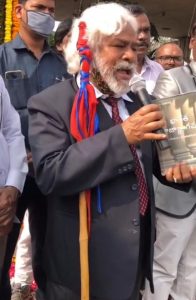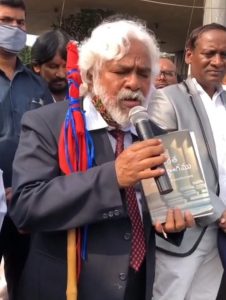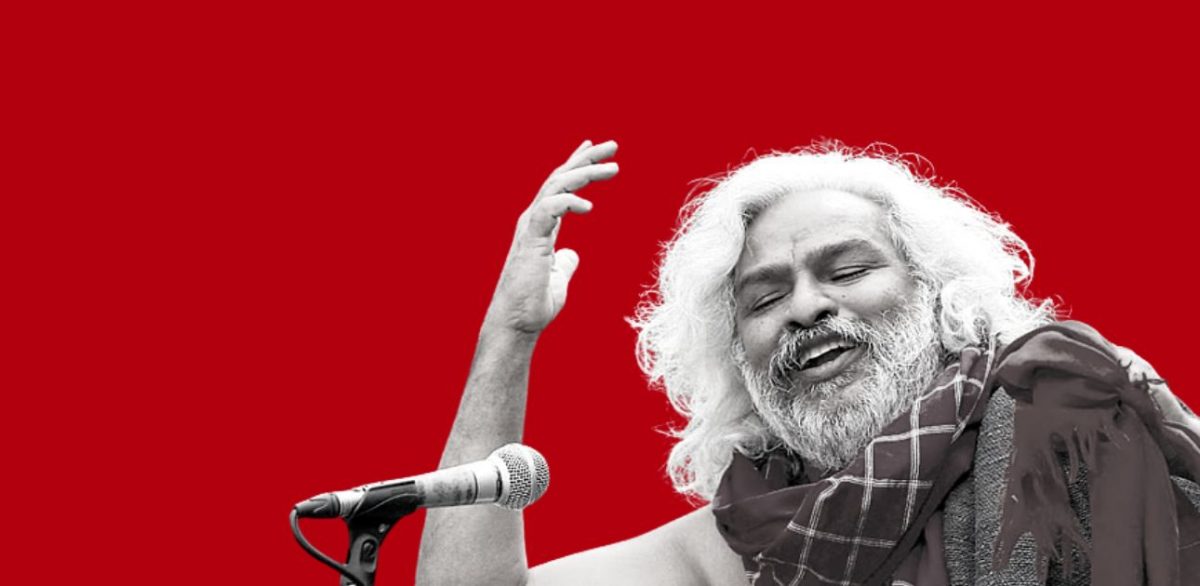Gummadi Vittal Rao—Gaddar— lived a life of song, dance and revolution. The State put six bullets in his body. Not only did he survive, he nursed one of them for 25 years. That bullet is now buried with him as a testimony of his life and times.
—
GADDAR’S unexpected death on August 6, 2023 and his Buddhist burial as thousands thronged to catch a last glimpse of the dearly departed shall pave a new way for Indian communists.
Gummadi Vittal Rao, also known as Gaddar, was active in the Naxalite–Maoist insurgency, as well as the movement for Telangana’s statehood.
Prior to his death, he was known as a communist revolutionary singer, lyricist and stage performer.
A life of public performance as a revolutionary singer in villages and cities, facing state repression for decades, took his songs to almost every house.
Even the few years he spent underground did not douse his popularity. In fact quite the contrary.
He faced bullets fired by State agencies in 1997. He nursed a bullet in his body for the rest of his life and it has now been buried along with him. It stands witness to the trials and tribulations of this balladeer for centuries.
Communists, socialists, ex-communists and atheists must realise that Gaddar turning to Navayāna Buddhism in his death was a revolutionary counterpoint to the Hindutva forces in the present atmosphere.
If only his body was burnt to ashes, the ash from his burnt flesh and bones would have suffused the bullet with an unintelligible memory. In that case, no one would be able to decode the amalgamation as historical testimony, though!
A Maoist, Buddhist and Ambedkarite; and an eternal revolutionary
Gaddar lived the life of a Maoist and, later, as a Buddhist Ambedkarite, but his death with a Buddhist ritualistic burial made him a representative of peace after having been a sufferer for 25 years of painful days and wounded nights.
Despite his struggles, he never stopped writing, singing and dancing till his death.
Communists, socialists, ex-communists and atheists must realise that Gaddar turning to Navayāna Buddhism in his death was a revolutionary counterpoint to the Hindutva forces in the present atmosphere.
His path has become that of a communist-Buddhist nationalist alternative to Hindutva nationalism.
There is a major solution here.
Atheism does not perturb Hindutva forces as they have created an atmosphere of ‘religion as superstition’ with a grip of mantric mysticism over the masses.
If all communists, socialists and atheists follow the path of Gaddar, who lived as an unparalleled revolutionary all his life with a most creative message through song, dance and speech that no contemporary communist could do, India will surely find a new path.
Also read: Mythily Sivaraman: A Pioneering Revolutionary
He was a philosopher effectively communicating his philosophy through lyrics and music.
He was a master singer with a melodious tone and the best of performers, whose handsome face and robust body worked like a rubber robot on the dias in public.
Normal cultural heroes do become social-spiritual reformers. But Gaddar blended many anti-Hindutva essences into one inside himself.


After Dr B.R. Ambedkar, it is Gaddar who has shown a new path for the Dalit family, communist culture and Telugu land, which was the place of the first major anti-feudal armed struggle of Telangana.
The Rashtriya Swayamsevak Sangh can claim Jyothi Basu, Charu Majumdar, Puchalapalli Sundarayya, Kondapalli Seetharamaiah, Tariela Nagi Reddy, Devulapalli Venkateswara Rao and Chadra Pulla Reddy as Hindus.
Normal cultural heroes do become social-spiritual reformers. But Gaddar blended many anti-Hindutva essences into one inside himself.
But these people never understood the alternative spiritual and caste-centred Hinduism, which is now being equated with Sanatana Dharma.
In India, given the history of Brahmanism that takes the shape of every snake, it can incorporate anybody but certainly not Buddha, Ayothidasar, Ambedkar and Gaddar, because they left evidence in every step of their life alternatives to Brahmanism, Sanatanism and Hinduism.
Sitaram Yechury, Prakash Karat and D. Raja also cannot escape their enlistment in Hinduism, if they do not swiftly declare their spiritual alternative.
Gaddar’s Navayāna Buddhism can counter the false Hindutva nationalism with a blend of communism, socialism and nationalism.
He lived with a bullet sitting in his spine for more than 25 years. That life is unparalleled in human history. He survived six bullets that pierced different parts of his body.
We do not know any soldier who fought any war, including World War I and II, who survived six bullets in the body and lived with a bullet in the body for such a long time. Gaddar’s life is unique in human history.
Such a life made him a man of massive popularity and loving respect.
In the united Andhra Pradesh before bifurcation of the state in 2014 into two states, Andhra Pradesh and Telangana, Gaddar had a huge fan following for his songs and dance.
His commitment to the cause of human liberation from hunger and exploitation made him live a life of suffering, while singing and dancing.
Though later some Andhra people might have disliked his role in the Telangana movement that fought for separation of the state from 1996 till 2014, he remained very popular in Andhra Pradesh after the division too.
As a writer and artist he was a unique political, literary and cultural icon known all over India.
The manifest symptoms of a malady
His divorce from the Maoist party in 2012 was about serious ideological issues that he put before his underground party.
He proposed that the party should fight against caste and class, by recognising Jyotirao Govindrao Phule, also known as Mahatma Phule and Ambedkar, along with Karl Marx, Vladimir Lenin and Mao Zedong, to suit the Indian conditions.
He also started writing songs and started performing about caste’s negative role in India.
The Maoist party rejected his proposal and issued a show cause notice against him in 2010. His work was considered anti-party and his understanding was dubbed anti-Marxist.
As he had anticipated his expulsion, Gaddar resigned from the party in 2012.
His efforts to change the line of his party to suit Indian caste–class exploitation should not go unrecognised.
He openly declared his spiritual and social allegiance to Ambedkarite Navayāna Buddhism and wrote several songs on Dalit and women’s oppression.
Also read: Pash’s poems continue to inspire revolutionary struggles
His song on women’s wage-free work at home “O my husband, what is the wage for my washing clothes and dishes; what is the wage for my sweeping the house and giving birth to a baby and feeding the baby to become a future human being” tells about the deepest human essence in him.
He was not a mechanical Marxist, Buddhist or Ambedkarite, but a human being of the highest sensitivity. He continued to be a thinker, writer, singer and dancer till his last days.
Just before his death he wrote an elegy in a song about his own death. In that he mourned, “Who will preserve the bullet sitting in his body?”
Of course, it is now preserved in his grave as fossil evidence of the rulers’ brutality on humanity.
It is a known fact that communist leaders in India never accepted social reform as a necessary issue along with class struggle.


Indian social reform encompasses spiritual reform along with dignity of labour and women’s equality with men.
He was not a mechanical Marxist, Buddhist or Ambedkarite, but a human being of the highest sensitivity. He continued to be a thinker, writer, singer and dancer till his last days.
The final form of that would be annihilation of caste, abolition of poverty, hunger and women’s inequality.
However, in spiritual terms, the Indian communists declared themselves as atheists and basically focused on class questions as economic determinists.
But in reality most of them die as Hindus. Their atheism in day-to-day life does not relate itself to any form of social reform.
Gaddar gave them a major social and spiritual reform programme in his death.
Caste-blighted birth redeemed by a death seeking freedom
Ambedkar said: “I had the misfortune of being born with the stigma of Untouchability. However, it is not my fault. But I will not die a Hindu, for this is in my power.” He became a Buddhist and died.
Gaddar was born as an Untouchable, as it was not in his power.
He worked in the communist revolutionary party which had many armed squads. He was their Parja Youdda Nauka (the ship of a people’s war).
After decades as a mover of that warship he realised that without Ambedkar, who used the power in his hands at the time of his death to die as a Buddhist with a message of peace, change would be possible.
The guns he supported all his life cannot liberate from Untouchability. He, therefore, became a Buddhist and got liberated from Untouchability.
More importantly, as a person who fought against that a State system that burnt hundreds of dead bodies, killing people in fake encounters after torturing them so that no evidence of torture could be left behind, Gaddar wanted his body and the bullet to be buried at a marked place in the premises of the English school that he built for the children of his basti.
If those so-called encounter bodies were buried even after decades they could have been exhumed and re-examined. Gaddar, therefore, preferred to be buried along with the bullet in his body.
It was Chandrababu Naidu who had blood on his hands as he was the ruler of the undivided Andhra Pradesh at the time.
The guns he supported all his life cannot liberate from Untouchability. He, therefore, became a Buddhist and got liberated from Untouchability.
Interestingly, the party was named by Naidu’s father-in-law as Telugu Desam Party and Gaddar is the most powerful Telugu writer, singer and communicator that the Telugu land has ever produced.
The nation will excuse if Chandrababu, at least now, goes to his body and the bullet in the grave in the school, Mahabodhi Vidyalaya, prostrates, and tells the truth about what happened on April 6, 1997 when he was the chief minister of Andhra Pradesh.
He can certainly live as a human being after that confession for the rest of his life.


